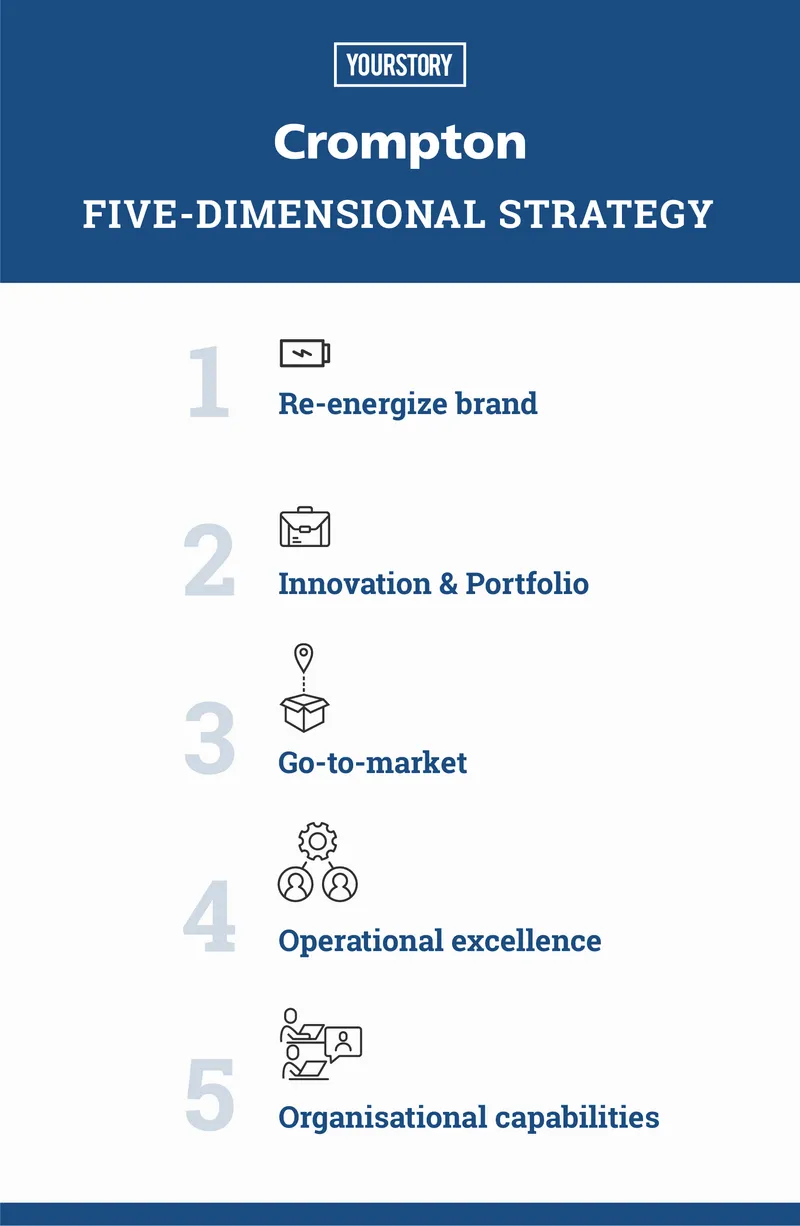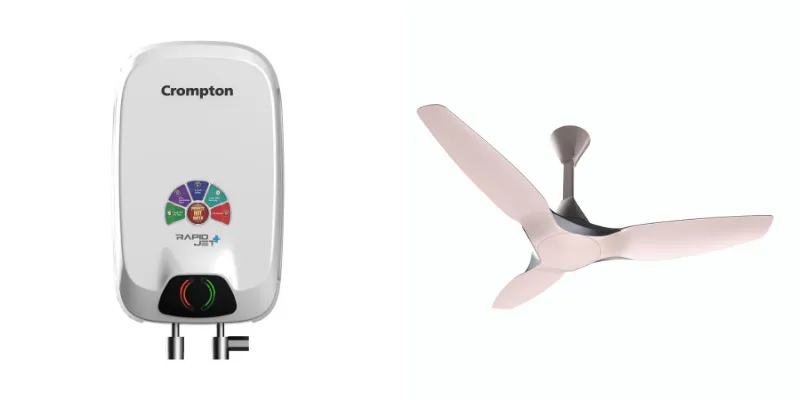Acquisition, mergers, and demerger: How Crompton Greaves clocked Rs 4,520 Cr turnover in 2020
Electrical consumer durables brand Crompton Greaves holds a 75-year-legacy in the Indian market. After five years of demerger with its parent company, the NSE-listed company has now grown to rake in Rs 4,520 crore turnover in 2020.
A brand with over 75-year-old legacy, Crompton Greaves Consumer Electricals Ltd. holds a long history of acquisitions, mergers, and demergers, and has today become a prominent name in the electricals category. One of the leading Indian consumer durables brand, it captures 21 percent market share in the fan category, according to Statista.
The company’s journey dates back to the pre-independence era when Colonel REB Crompton started ‘REB Crompton & Co’ in 1878 in England to manufacture and contract electrical equipment. Later, in 1927, it merged with another company called F&A Parkinson Limited and ‘Crompton Parkinson Limited’ (CPL) was established with its wholly-owned Indian subsidiary located in Mumbai, along with a sales company called Greaves Cotton & Crompton Parkinson Ltd.

Image credit: YS Design
In 1947, the company was taken over by an eminent Indian industrialist - Lala Karamchand Thapar, who formed the Thapar Group, unifying both ‘Crompton Parkinson Limited’ and its sales organisation ‘Greaves Cotton & Crompton Parkinson Ltd.,’ to create ‘Crompton Greaves Ltd,’ in 1966. The company was working steadily to meet both B2B and consumer demands simultaneously. The B2B segment played a pivotal role in the company’s growth, but to strengthen its consumer vertical, which was contributing 25-30 percent of its revenue, the management decided to demerge the two verticals.
In 2015, the consumer business of the company was demerged to form a separate entity, which we now know as ‘Crompton Greaves Consumer Electricals Ltd.’ (CGCEL). The erstwhile Crompton Greaves Ltd. changed its name to CG Power and Industrial Solutions Limited.
In an exclusive interaction with SMBStory, Mathew Job, CEO of CGCEL, speaks about the demerger and the marketing strategies the company incorporated to fuel growth in the next five years. Today, the brand has become one of the fastest growing Electrical Consumer Durables (ECD) companies, has become EBITDA positive, as well as high in ROCE (Return on Capital Employed).
“The company holds a long history of success and accomplishments. After the demerger, the challenge was to maintain the strength of the brand and build the company. From 2015 to 2020, CGCEL has moved beyond its traditional imagery to a contemporary and innovative organisation,” says Mathew.
The business
Crompton is one of the leading ECD companies in India and its portfolio includes fans, LED lighting, water pumps, and household appliances such as water heaters, air coolers, and kitchen appliances.
The Mumbai-headquartered company has seven manufacturing plants across India in Baroda, Goa, Baddi, and Ahmednagar, with more than 30 sales offices, over 10,000 SKUs to choose from, and providing employment to more than 1,500 people across India.
Mathew says, the company also aligns with Prime Minister Modi’s vision of Aatmanirbhar Bharat, and makes India self-sustainable. As of now, the company exports only two percent of its production, sources 90 percent of the raw materials locally, and manufactures partly through third-party factories located within the country.
The company became an independent listed company on the NSE in 2015 and raked in Rs 4,520 crore turnover in 2020.
The five-dimensional strategy
After the demerger in 2015, Crompton followed a five-dimensional strategy, which according to Mathew helped the brand to not only perform well, but become one of the leading companies in the immensely competitive electricals industry. According to IBEF, the industry is expected to double to reach Rs 1.48 lakh crore ($21.18 billion) by 2025.
To begin with, the company worked to re-energise the brand to step up its marketing spend. “We initiated various marketing campaigns and leveraged marketing expenses, which Crompton lacked before,” he says.
The company also innovated its portfolio strength by bringing to the fore anti-dust fans, which Mathew says attracts 50 percent less dust compared to the traditional fans. It also launched anti-bac LED lamps that kill 85 percent of germs, optimum performance series of water pumps, high performance water heaters, and more.

Image Credit: YS Design
Being conventionally known as a leading player of fans and garnering more demand from consumers for the same, it was a dire need for Crompton to go to the market and make its other verticals grab attention.
The company then made consumer home visits to understand their complaints, and introduced features to solve consumer problems. The company also organised focussed group discussions and tracked social media to read consumer reviews on certain products, which let Crompton make consumer durables actually more durable for them.
Another prime strategy that Mathew says they involved was making Crompton available to consumers directly.
“Traditionally, Crompton was dependent on wholesale distribution. You see, we were traded heavily. From Lahaul in Mumbai to Bhagirath Palace market in Delhi; the company had a wide wholesale presence, but retail was weak and we didn’t know where our product was going,” Mathew tells SMBStory.
The company linchpinned on increasing its retail presence and ensured it was present in approximately 60 percent of the electrical goods stores in India during the year 2019-20.
Mathew says, another strategy the company incorporated was making operational excellence and enhancing organisational capabilities by hiring new talent. The company utilised the value of data by building a huge digital sales data bank at the distributor and retail levels, and this data analytics helped drive sales and increased the productivity of people.
Challenges and the competition
One of the major challenges of the company was to do with growth. Hence, the company decided to disrupt its business model and incorporated digital technologies to scale and see success.
“We have seen aggregation of demand and supply by many ‘app’ startups that have disrupted industries like taxis, etc., and navigating this landscape profitably will be a great differentiator going forward,” Mathew says.

Crompton Greaves geyser and fan
The approximate size of each of Crompton’s categories are: fans – Rs 8,000 crore, lighting – Rs 11,000 crore, domestic and agricultural pumps – Rs 7,000 crore, and appliances (water heaters, air coolers, and mixer grinders) – Rs 4,500 crore.
While Crompton, as a brand, has stood for great quality, durability, and expertise in electrical engineering, and has been trusted by consumers across the country for many years, it is now focusing on building on this legacy in a more contemporary and innovative manner.
Going digital
Crompton is leaving no stone unturned and is working on introducing SKUs to enhance its portfolio to dominate the ECD segment. It is also working to build both the depth and width of its distribution network across the country.
“There is still a long way to go. Apart from this, the consumer behaviour has shifted towards digital media due to the pandemic. The consumer behaviour pattern has changed from evaluating the product by use to reading user reviews and feedback on digital media,” he says.
The emergence of ecommerce as a prominent channel for ECD consumers is necessitating the company’s focus in this direction as well.
Mathew says, even though the role of ecommerce in electricals category is only four to five percent, but the fact that it is growing cannot be ignored. The brand is available on Amazon and Flipkart for now, and with the fact that D2C is increasing, Crompton is making all efforts to venture into this segment.
Edited by Megha Reddy








